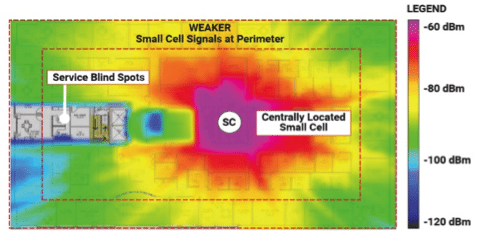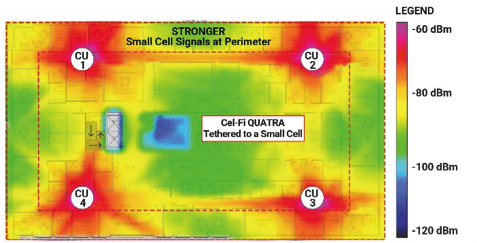Those in the in-building wireless (IBW) market have heard about different “hybrids” to fix the indoor cellular connectivity problems virtually every enterprise experiences. Whether it’s in the board room, the CEO’s office, or during an important sales call – dropped calls, poor cellular reception, and black holes negatively impact business operations.
Now there is one hybrid that specifically addresses the challenges of poor indoor cellular coverage in the underserved middleprise market for spaces between 10,000 to 200,000 sq. ft. and can be deployed in a matter of days by a certified installer at a compelling price.
Cel-Fi QUATRA is an active DAS hybrid solution for delivering high quality in-building cellar coverage in venues up to 200,000 sq. ft. It combines the best of active DAS and the Cel-Fi technology that has been widely adopted by wireless carriers and enterprises around the globe. Cel-Fi QUATRA was designed to overcome the obstacles that exist today to the wide-scale adoption of IBW solutions in the middleprise segment, and is ideal for spaces too large or demanding for smart signal boosters, but too small to be served affordably by classic indoor active DAS (iDAS).
Whereas iDAS is an excellent cellular coverage solution for very large venues over 500,000 sq. ft., the equipment and installation costs are excessive for the smaller middleprise budget. A passive DAS also has its uses, but as the cellular signal attenuates from the head end to the remote units (antennas) just by the nature of this technology, it does a poor job at distributing strong signals uniformly throughout a building. Passive DAS systems also often require costly service calls to optimize the system to accommodate changes in the environment.
Small cells remain and will continue to be the technology of choice for adding cellular capacity to densely populated or larger enterprise venues. While small cells offer the added benefit of offloading capacity demand from the macro network, they also come with issues that have yet to be resolved:
- Small cell deployment is not as easy as it is promoted. The ‘self-install promise’ made by the small cell industry has not yet become entirely true.
- Interference between multiple small cells is still a challenge; it is not easy to detect interference in a self-installation.
- Performance of corporate DSL connections can be impacted when multiple small cells are installed.
- Lead times for enterprises to obtain small cells from the operators needs to improve exponentially to meet customer demand.
QUATRA leverages the strengths of DAS and small cell technologies, while eliminating the issues that have stood in the way of widespread middleprise adoption of these solutions. There are a number of reasons Cel-Fi QUATRA makes massive in-building densification possible:
- Provides an in-building coverage solution for commercial spaces 10K-200K sq. ft. at a compelling price; scalable so future-proofed for company growth.
- Can be deployed by a certified installer in a few days, rather than the months it takes for a traditional DAS.
- While site surveys are recommended, highly sophisticated design tools, like iBWave, are not a prerequisite.
- Leverages proven Cel-Fi technology that is unconditionally network safe and has been widely adopted by carriers and enterprises world-wide.
- Delivers up to 1000x the off-air signal gain of other coverage solutions on the market.
- Intelligently self-optimizes in response to environmental changes, eliminating network interference and costly service calls to reconfigure systems.
- Remote units are smart powered antennas (thus the “active” in “Active DAS Hybrid”) creating a larger coverage footprint per remote unit.
- Cel-Fi QUATRA’s digital distribution architecture over Ethernet eliminates attenuation between the head end and remote units, simplifying installation and providing improved coverage.
- The signal source for Cel-Fi QUATRA can be off-air, if a small cell is unavailable, or additional capacity is not a concern.
Supercell™ – more than a small cell on steroids
Carriers have historically had problems with interference on their macro networks when many signal boosters or repeaters have been randomly installed. In fact, in many countries around the world, repeaters are illegal for this very reason.
In-building small cells primarily provide the additional capacity necessary for densification. However, as stated above, when multiple small cells are installed in a venue, there can be interference between the small cells, and the performance of the corporate DSL network can be impacted.
A Supercell is the solution to the interference issues. A Supercell – a large single cell versus multiple small cells – is created when Cel-Fi QUATRA is tethered to a small cell. Multiple QUATRA systems can be connected to a single small cell or multiple small cells to form a coordinated Supercell that extends coverage for venues up to 200,000 sq. ft.
In addition to providing uniform access to the capacity provided by the small cell throughout an entire venue, the CAPEX for a Supercell is less than using multiple small cells as a coverage solution. A Supercell can also extend signal through difficult construction, isolated areas, even elevator shafts, thereby balancing the amount of coverage delivered with the amount of capacity needed – in a way that cannot be accomplished with a small cell alone.
Other benefits of a Supercell include:
- Signal dominance (power) over the outside macro network at the perimeter of the building so in-building calls stay on the in-building small cell where they belong.
- Elimination of other network interference problems, such as pilot pollution in a high-rise building where too many macro cell sites are visible and interfering with one another.


Middleprise rises to the top of the densification food chain
While densification of the largest venues has been accomplished in good part, the 1.5 million middleprise buildings in the USA from 10K – 200K sq. ft. continue to be plagued with areas that have poor cellular coverage. This market segment is the priority for Cel-Fi QUATRA.
In situations where an organization has a small cell on back order, a Cel-Fi certified integrator can install QUATRA with an off-air signal source, to address immediate IBW needs, and then tether QUATRA to the small cell as soon as it arrives from the carrier.
In many venues, QUATRA can be installed off-air without needing to add any capacity from a small cell. A certified installer is provided the necessary toolsets to rapidly determine the optimum and most cost-effective configuration for the venue.
The middleprise segment is no longer effectively excluded from densification initiatives. Cel-Fi QUATRA is the IBW solution that provides cellular coverage relief on an immediate basis, and is scalable by the enterprise as it grows.
For more information, download the white paper on the Cel-Fi QUATRA In-Building Enterprise Cellular System.
ABOUT THE AUTHOR:
Werner Sievers, CEO of Nextivity, is a veteran of the wireless industry. He has extensive leadership experience at internationally-focused semiconductor and wireless venture-backed startups and emerging growth companies, spearheading the successful development, launch, and acquisition of disruptive technologies and businesses. For additional information, visit cel-fi.com.

